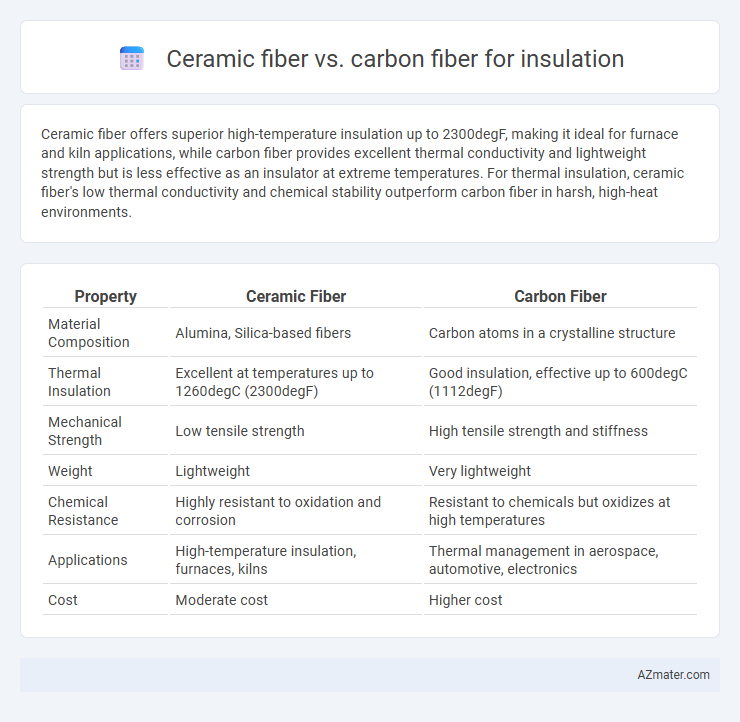Ceramic fiber offers superior high-temperature insulation up to 2300degF, making it ideal for furnace and kiln applications, while carbon fiber provides excellent thermal conductivity and lightweight strength but is less effective as an insulator at extreme temperatures. For thermal insulation, ceramic fiber's low thermal conductivity and chemical stability outperform carbon fiber in harsh, high-heat environments.
Table of Comparison
| Property | Ceramic Fiber | Carbon Fiber |
|---|---|---|
| Material Composition | Alumina, Silica-based fibers | Carbon atoms in a crystalline structure |
| Thermal Insulation | Excellent at temperatures up to 1260degC (2300degF) | Good insulation, effective up to 600degC (1112degF) |
| Mechanical Strength | Low tensile strength | High tensile strength and stiffness |
| Weight | Lightweight | Very lightweight |
| Chemical Resistance | Highly resistant to oxidation and corrosion | Resistant to chemicals but oxidizes at high temperatures |
| Applications | High-temperature insulation, furnaces, kilns | Thermal management in aerospace, automotive, electronics |
| Cost | Moderate cost | Higher cost |
Introduction to Ceramic Fiber and Carbon Fiber Insulation
Ceramic fiber insulation consists of alumina-silica fibers capable of withstanding extreme temperatures up to 2300degF, making it ideal for high-temperature industrial applications such as furnaces and kilns. Carbon fiber insulation offers excellent thermal and electrical conductivity, with superior strength-to-weight ratio, commonly used in aerospace and automotive sectors where lightweight, high-performance insulation is critical. Both materials serve unique insulation roles; ceramic fiber excels in thermal resistance while carbon fiber provides structural reinforcement alongside insulation properties.
Material Composition and Structure
Ceramic fiber insulation consists primarily of alumina and silica oxides, forming a highly porous and lightweight structure with excellent thermal stability and resistance to high temperatures above 1,200degC. Carbon fiber insulation is composed of carbon atoms arranged in a highly crystalline graphitic structure, providing superior tensile strength and thermal conductivity but with lower oxidation resistance compared to ceramic fibers. The amorphous, fibrous network of ceramic fibers offers superior insulating properties in high-temperature environments, while carbon fibers excel in applications requiring mechanical strength and conductivity.
Thermal Insulation Performance Comparison
Ceramic fiber offers superior thermal insulation with an operating temperature up to 1260degC (2300degF), making it ideal for high-temperature applications such as furnace linings and kilns. Carbon fiber, while providing excellent strength-to-weight ratio and thermal conductivity, typically operates effectively only up to 650degC (1200degF), limiting its use in extreme heat insulation scenarios. The low thermal conductivity and heat resistance of ceramic fiber outperform carbon fiber for thermal insulation, especially in environments demanding sustained high-temperature performance.
Heat Resistance and Temperature Limits
Ceramic fiber insulation offers superior heat resistance withstanding temperatures up to 1,260degC (2,300degF), making it ideal for high-temperature industrial applications such as furnaces and kilns. Carbon fiber insulation, while possessing excellent thermal conductivity and strength, typically endures maximum temperatures around 450degC (842degF), limiting its use in extreme heat environments. The choice hinges on temperature limits where ceramic fiber excels in extreme heat retention and carbon fiber suits moderate heat insulation combined with structural strength.
Mechanical Strength and Durability
Ceramic fiber demonstrates exceptional thermal stability and high mechanical strength even at elevated temperatures, making it ideal for insulation in harsh industrial environments. Carbon fiber offers superior tensile strength and durability with excellent resistance to fatigue and corrosion, beneficial for applications requiring structural integrity combined with insulation. Choosing between ceramic and carbon fiber depends on operating temperature demands and mechanical stress factors, with ceramic excelling in heat resistance and carbon fiber in mechanical endurance.
Weight Considerations for Insulation Applications
Ceramic fiber insulation typically weighs more than carbon fiber insulation due to its dense, fibrous structure designed for high-temperature resistance. Carbon fiber insulation offers a lightweight alternative, making it ideal for applications where reducing overall weight is critical, such as aerospace and automotive industries. Weight considerations directly impact insulation installation, handling, and thermal performance efficiency in these specialized environments.
Chemical Stability and Corrosion Resistance
Ceramic fiber exhibits superior chemical stability and corrosion resistance due to its inert composition, making it highly effective in harsh chemical environments and high-temperature applications. Carbon fiber, while strong and lightweight, is more susceptible to oxidation and chemical degradation when exposed to acidic or alkaline conditions. For insulation purposes in corrosive atmospheres, ceramic fiber ensures longer durability and consistent performance compared to carbon fiber.
Cost Analysis: Ceramic vs Carbon Fiber
Ceramic fiber insulation generally offers a lower initial cost compared to carbon fiber, making it a more budget-friendly option for high-temperature applications. Carbon fiber insulation, while more expensive upfront, provides superior strength-to-weight ratio and thermal stability, which can reduce long-term maintenance and replacement expenses. Evaluating total cost of ownership including durability, efficiency, and lifespan is critical when choosing between ceramic and carbon fiber insulation.
Typical Industrial and Commercial Uses
Ceramic fiber insulation excels in high-temperature industrial applications such as furnaces, kilns, and boilers due to its excellent thermal resistance up to 2300degF (1260degC) and low thermal conductivity. Carbon fiber insulation, valued for its lightweight and high strength, is commonly used in aerospace, automotive, and electronic industries where thermal stability and electrical conductivity are critical. Industrial sectors prioritize ceramic fibers for heat containment and energy savings, while carbon fibers are favored for advanced insulation requiring durability under mechanical stress and electromagnetic shielding.
Choosing the Right Fiber for Specific Insulation Needs
Ceramic fiber offers exceptional thermal resistance up to 2300degF, making it ideal for high-temperature insulation in furnaces and kilns, while carbon fiber excels in lightweight, high-strength applications with moderate thermal resistance around 600degF. Choosing the right fiber depends on the specific insulation requirements: ceramic fiber is preferred for extreme heat and chemical stability, whereas carbon fiber benefits applications needing structural reinforcement alongside thermal insulation. Consider factors such as operating temperature, mechanical strength, chemical exposure, and budget to select the optimal fiber for targeted insulation performance.

Infographic: Ceramic fiber vs Carbon fiber for Insulation
 azmater.com
azmater.com